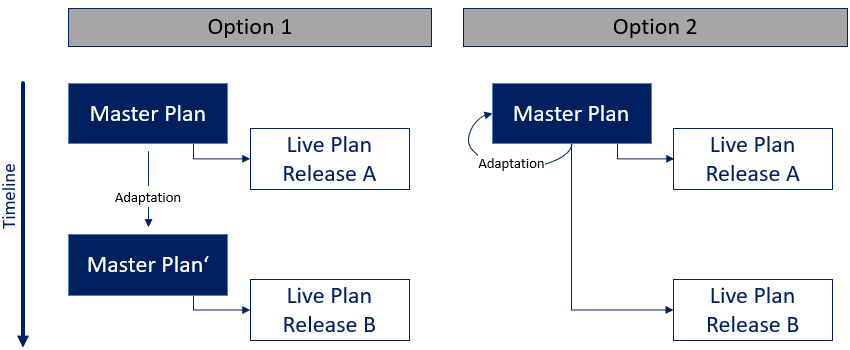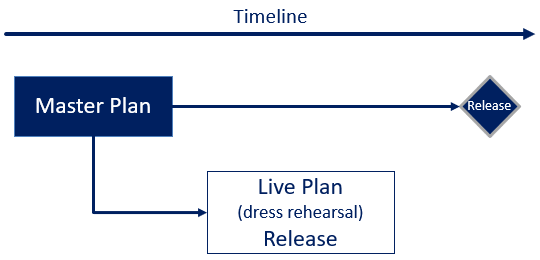Release Plan: Structured planning and execution
Coordinated release deployments in complex IT landscapes.
The requirements of the market, the legislator and the regulatory authorities are constantly increasing. Accordingly, the system landscape of a company must be continuously adapted to meet the new requirements. For this reason, new systems/modules are either developed in-house or corresponding standard solutions available on the market are integrated into the existing system environment. The result is an increasingly complex IT landscape and, as a consequence, more and more demanding release planning.
Release cycle
One method of being able to introduce bug fixes, change requests and larger requirements into the IT landscape in an orderly manner and with a manageable amount of effort and risk is to have longer release cycles. For this reason, many companies now only issue releases 1 to max. 4 times per year. The fewer releases per year, the more systems are usually involved. Either because the respective systems have been adapted to the software or because interfaces to peripheral systems have been modified and therefore the corresponding counterparts have to be adapted and tested.
These major releases require extensive testing and precise implementation planning and execution. This is where the release plan comes into play, which provides a chronologically ordered list of all tasks and their dependencies among each other. Usually, these releases are installed on weekends in order to disturb the daily routine and internal and external processes and actions as little as possible. Customer portals are shut down and various services are stopped. In short, there is a multitude of tasks in IT, business departments and occasionally also with external partners, which have to be coordinated during a release installation.
Due to the high number of tasks, as well as the often tight schedule (e.g. within one night, weekend or day) and the different parties involved, it goes without saying that an orderly control, implementation and monitoring is required for this project. At this point, cutover management as an established methodology for cutovers is also suitable for release introductions.
Cutover management includes the planning and control of preceding preparatory and subsequent final work, dress rehearsals and the actual cutover/go-live. In this case the planning and control of complex and extensive release deployments.
In cutover management, particular importance is attached to the meticulous planning, coordination and management of a large number of tasks with many people and/or groups/teams involved. Thus, it fulfills the requirements of complex releases 100%.
Any methodology is only as strong in practice as it is supported by software. Accordingly, we recommend the use of professional cutover software, such as the CutoverManager, for optimal support of cutover planning and execution/control.
Release plan vs. cutover plan
In a release plan, as in a cutover/go-live plan, the tasks associated with the release must be collected, planned and managed in detail. This includes the management of the dependencies of tasks, the responsible users and/or teams, the possibility of task groupings and the management/documentation of various task properties and details.
Depending on the size of a release, a release plan differs from a cutover plan in terms of the amount of tasks and the required functions. Our experience shows that in most companies, a release plan is set up, coordinated and managed centrally by one person, the release owner or the test manager. Microsoft Excel is usually used as a tool. The Excel plans are optimized with macros and/or functions in different intensity.
In contrast to the release plan, in a cutover plan are usually:
- more tasks managed
- more dependencies between tasks defined
- more involved persons and/or teams managed and coordinated
- more groupings done
- etc.
As a result, a release plan has basically the same requirements as a cutover plan, but the complexity is only a fraction of a cutover plan. Especially in release planning, the expected complexity can easily be underestimated at the beginning. Only in the course of planning does it often become clear how complex the release plan is and how important a reliable and easy-to-use planning and control tool becomes.
Since the risk of deployment failure must be reduced as much as possible even during a release introduction, it is recommended to use a cutover plan in conjunction with professional cutover software from the very beginning. This combination scales (several thousand tasks) and makes a valuable contribution to risk minimization.
CutoverManager
As professional cutover software, the CutoverManager offers the optimal conditions for release planning and control of the release deployment. The possibility to run several cutover plans (called master plans in the CutoverManager) in parallel and to clone/copy them as often as desired, allows to build on the plan of the previous release or a general plan for each new release and to adapt it individually.

For larger releases, especially the pre- and post-processing tasks are usually very similar. It can therefore be based on proven processes:
- Shutdown/Start-up of interfaces
- Deactivating/Reactivating of jobs
- Activating/Deactivating of failure pages
- etc.
In a copied plan, the previously created resources and labels (grouping criteria such as systems, locations, etc.) are still available and do not need to be entered again. The new plan can be adapted as desired, i.e. new tasks can be inserted at the required position, dependencies can be changed as desired, required tasks or task blocks can be left as they are, or time adjustments can simply be made.
A dress rehearsal can also be held for larger releases. For this purpose, an executable live plan can be created from the master plan — with an appropriate start date.

Due to the integrated function of the automatic initiation of tasks in the CutoverManager, there is no need for a Cutover Manager in persona to actively control the plan. The employees responsible for the respective tasks can independently mark their tasks as started and completed after receiving an initiation mail. The Cutover Manager periodically checks the active plan and notifies the responsible persons about tasks to be started.
If no unplanned events or delays occur, the CutoverManager takes over the central control of the release introduction. The CutoverManager also independently takes over the creation of management mails when milestones are reached, if the appropriate parameters are set. For the mails for starting tasks and the mails when reaching milestones, different mail templates can be stored according to the different addressees.
The CutoverManager is therefore the optimal tool for planning and execution not only for cutover projects but also for recurring releases.
Conclusion
A cutover plan is a scalable release plan. The use of professional cutover software enables not only centralized maintenance but also – especially in today's remote working environment – decentralized maintenance and execution control. Further arguments in favor of using cutover software for release planning and introduction are: the coverage of all functional requirements, security through a stable IT solution with controlled process flows and solid data management.
Find out for yourself what potential the CutoverManager has to offer. Please use our online demo. You are also welcome to contact us directly if you have specific questions. We are looking forward to meeting you.
Changelog
November 18, 2020 – text revised
April 12, 2020 – headlines revised
March 19, 2019 – publication
Recommended content
- Cutover – The supreme discipline of system launches
- Cutover Management
- Cutover: Successful planning and controlling with the CutoverManager
